TRAINING METHODS & PROGRAMMING
A determination of the individual needs of the athlete is important to ensuring that the testing done during the RTP process accurately assesses the demands that will be placed on them. This is done with a needs analysis of the sport and should be specific to the position the athlete plays as well as the level of competition they participate in (e.g., collegiate, amateur, professional). An in depth discussion of this processes is beyond the scope of this paper and the reader is referred to the following papers for an exploration of this topic in full. Numerous factors must be considered when deciding what to emphasize within training, such as the time since the initial injury, what has been done to date, and the time frame available before RTP. Communication between professionals involved in the RTP decision at this point will help to ensure that the RTP process is optimized.
The manipulation of acute training variables dictates the response the athlete has to the training program. Buchheit and Laursen recognize nine variables that can be manipulated within an energy system training session (Table 3). The manipulation of training variables can be used to change the focus of the session or to aid in selecting modalities (e.g., cycling, rowing) that may be appropriate during phases of the RTP process when activities like running are contra-indicated. These variables offer the practitioner a number of options for creating a training program. Table 4 provides guidelines for the manipulation of these variables based on the objectives of the training session (e.g., short duration or long duration) and training modalities that might be appropriate for the individual at that time. The clinician is advised to utilize this framework when designing programs.
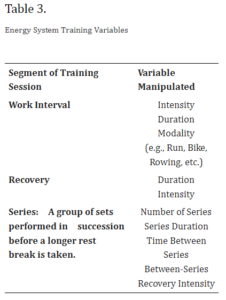
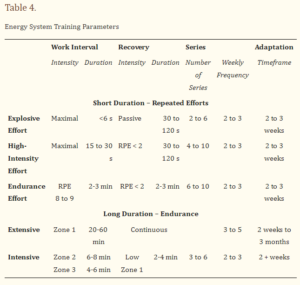
When designing training programs, the practitioner is required to determine the appropriate training intensity for a given training session. Prescription of intensity has been based on of a number of physiological measures in the literature including maximal heart rate, VO2max, aerobic and anaerobic threshold, and critical power. Traditionally a percentage of these values are utilized to prescribe an internal (%VO2max, % threshold) or external (% critical power) intensity in either a continuous or interval-based prescription. With the popularity of interval-based prescriptions (see Training Methods & Programming) it is imperative that the practitioner not only considers the intensity of the exercise bout, but also the intensity of inter-interval recovery periods and inter-series recovery. Technology, such as GPS monitors, heart rate monitors, and power meters, may assist practitioners in directly quantifying training intensity, however, expense may limit their applicability in certain situations. The use of perceived intensity and duration make for an affordable solution that is easy to implement in any setting.
The rating of perceived exertion (RPE) is one of the most recognized measures for monitoring training intensity during a workout. Using this method clinicians may then prescribe exercise intensities within a binary or 3 zone model as shown in Table 5. The binary zone model differentiates low vs. high-intensity with respect to the first blood lactate threshold (2.5 mmol/L) or 72% HRmax, whereas the 3 zone model includes intensities below 2.5 mmol/L blood lactate or 55-82% HRmax as zone 1, 2.5 mmol/L to 4.0 mmol/L blood lactate or 82-87% HRmax as zone 2, and >4.0 mmol/L blood lactate and >87% HRmaz as zone 3.47 The RPE scale most often used is the modified CR10 scale seen in Table 7.These parameters offer a flexible model for developing both anaerobic and aerobic qualities in the injured athlete.
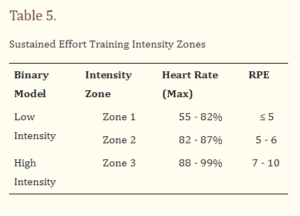
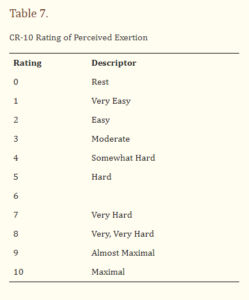
The classification system established in Table 2 gives the practitioner a framework that can be used for designing and progressing the individual rehabilitation program. Key training sessions throughout the week would be designed to improve the predominant energy system demands required by the sport and position the athlete competes in. For example, the sport of American football is an intermittent sport comprised of repeated, high-intensity efforts of approximately 4 – 7s, followed by 15 – 80s of recovery, which would be considered “Explosive Effort” per Table 2. As such, the goal of the programming would be to maximize the various energy systems ability to tolerate these demands. Table 6 provides an example program demonstrating application of the various principals to a specific case. Training modalities should progress as the athlete moves through the RTP program. For example, the athlete may begin performing bike workouts, if running is initially contraindicated due to their injury, and then progress to linear running, change of direction running, and finally to open environment skill work, where the athlete must sprint at a high level whilst making decisions and changing directions. Similarly, exercise intensity would progress from lower intensity work to explosive efforts of straight ahead running, to change of direction work performed under similar work-to-rest ratios specific to the game. Finally, the athlete’s program would be progressed from longer rest intervals to rest intervals that are more sport specific.
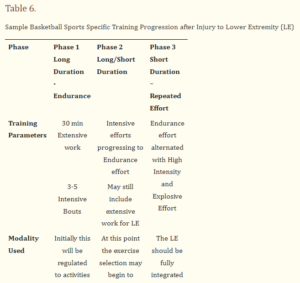
Reference: https://www.ncbi.nlm.nih.gov/pmc/articles/PMC5534159/





